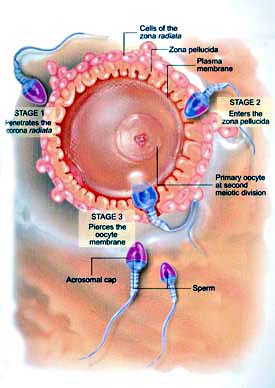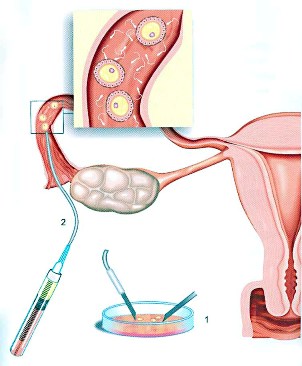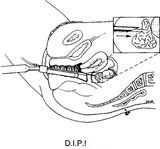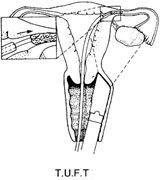Assisted Reproductive Technology (ART)
This term refers to the methods that are used to help couples with fertility problems to achieve pregnancy and it is used with in some cases where genetic issues are present. In these methods, the sperm is selected in the lab and transferred at the time of the woman's ovulation, either into her uterus or to the fallopian tubes, or directly to the ovarian follicles. The sperm can be injected into the ovarian follicle after it is aspirated outside the woman's body in the process known as InVitro Fertilization (IVF).
Indications of Assisted reproductive technology (ART): 
- Endometriosis.
- Irregular ovulation, as in polycystic ovarian syndrome.
- Abnormal semen fluid analysis.
- Presence of any disorder in the couples that is diagnosed by the physician.
- Cervical problems such as presence of thickened mucosal discharge, or presence of sperms antibodies.
- Unexplained infertility.
- Blocked or damaged fallopian tubes.
- Women at age of 35-40 years.
- Men that have anti-sperm antibodies.
Semen preparation in assisted reproductive technology (ART):
There are several techniques that can be used for semen preparation. Since the introduction of IVF, research is still going on to determine the best method to prepare the semen.
Sperm washing is done by removing the chemicals that may cause adverse reactions in the uterus. Bacteria, white blood cells and dead sperm, that can impair egg fertilization will be separated from the fluid portion of the semen. If needed, special additives can be incorporated to increase sperm motility and its ability to fertilize.
Before semen preparation, an evaluation of the ability of the sperm to fertilize, is completed. The main purpose of the scientists is to reach the correct diagnosis, and to treat any defect in the production or function of the sperm, and to improve the sperm's ability to fertilize, to increase the rate of pregnancy.
Types of Assisted reproductive technology (ART):
The following types of ART are not used now, but they were developed early and were done in the first few years of developing ART
Fallopian tube sperm perfusion (F.S.P):
This method is done by introducing the whole semen into the uterus to reach the fallopian tubes. The amount of semen used in this method is 4 ml and it is more than the amount of semen used during intrauterine insemination (IUI) which is around 0.3-0.8 ml. Some believe that this method has a higher pregnancy rate than the intrauterine insemination (IUI) because more semen is used and, as it is introduced to more areas, including the uterus and the fallopian tubes. But it is worth mentioning that there are different studies on this topic with different results. The decision to choose between ( IUI) or (FSP) must be taken by the physician. This method has the same indication and the same technique as IUI.

Trans-vaginal Intra-Fallopian Insemination (T.V.I.F.I):
This is done by introducing a catheter through the cervix to reach the fallopian tube, then the sperm is injected inside the tube. The purpose of this method is to introduce the sperm directly to the natural place of fertilization, which is the fallopian tube.
Direct Intra-Fallopian Insemination (D.I.F.I):
It is done by injecting the sperm into the ovarian follicle, within the ovary, by using the trans-vaginal ultrasound.
Gamete Intra-Fallopian Transfer (G.I.F.T):
This method came into use in 1984 and it is done by stimulating egg production in the ovaries by using fertility drugs. The eggs will be collected from the ovaries and placed with the sperm in one of the fallopian tubes The fertilized eggs (zygotes) will travel toward the uterus and will be implanted in the inner lining of the uterus (the endometrium). This method takes about 30 - 60 minutes from the time of removing the follicles until it is placed in the fallopian tube with the sperm. It is done either by laparoscopy or using trans-vaginal ultrasound.
- Cases that can benefit from this method:
- Women that have patent and healthy fallopian tubes.
- Women with endometriosis, if the fallopian tubes were patent and healthy.
- Men that have Oligospermia, in which the follicles will be aspirated from the ovaries then they will be mixed directly with the semen that is prepared for this purpose.

Zygote Intra-fallopian Transfer (Z.I.F.T):
This method is similar to (G.I.F.T). The only difference is that the embryo will be transferred to the fallopian tube after the fertilization has occurred in the lab, as in IVF, (while in the G.I.F.T method, the fertilization happens in the fallopian tube), then the zygote will be transferred to the fallopian tube to continue its natural divisions and will migrate towards the uterus where it will be implanted And of course, the fallopian tubes must be healthy.
It is worth mentioning that the pregnancy rate in the (G.I.F.T) method, when done for the cases of abnormal semen, is less when it is compared with other fertility problems, such as unexplained infertility, endometriosis, cervical factors…., etc. In addition, using abnormal semen makes it difficult to know if fertilization has occurred or not. For that reason, the scientists developed the (G.I.F.T) method into (Z.I.F.T).
Tubal Embryo Transfer (T.E.T) and Pronuclear Stage Transfer (P.R.O.S.T):
The difference of names for this method depends on the stage of embryo growth and development before it is transferred to the fallopian tube. The program begins by stimulating the ovaries. Then the eggs are collected from the ovaries and sent, with the sperm, into the lab, where the eggs are fertilized by the sperm to produce embryos. They will then be transferred to the fallopian tube in the same way as in the Z.I.F.T. Method. Then the embryos will continue their divisions, naturally in the fallopian tube, and will continue the journey until they implant in the uterine inner lining.
- - What is the difference between (T.E.T), (T.U.F.T), (P.R.O.S.T), and (Z.I.F.T) methods?
All these methods are the same, in which we stimulate the ovaries to produce mature follicles. Then, H.C.G. hormone is given at the appropriate time. And the mature follicles are collected by trans-vaginal ultrasound and fertilization is carried out in the lab.
The only difference in these four methods is the stage at which the fertilized egg is transferred to the fallopian tube. In (Z.I.F.T) and (P.R.O.S.T) the fertilized egg is transferred to the fallopian tube at the Pronuclu stage that is reached after 18 hours of adding semen to the follicles. On the other hand, the fertilized egg is not transferred until 18 hours of adding the semen to the follicles in T.U.F.T and T.E.T methods and at that stage the fertilized egg is divided into 2 or more cells and called a, “Pre-Embryo.”
These methods are preferred to be used particularly in cases of male infertility, as the follicles can be exposed to a higher number of sperm and the development of the fertilized egg can be monitored outside, unlike the G.I.F.T method that was mentioned above.

The further difference between these four methods and the IVF method is that the fertilized egg is transferred in to the fallopian tube and not to the uterus as in IVF. The egg has more space to develop in its natural environment. And the success rate in these methods is 17-37% during each menstrual cycle.
Direct Intra-peritoneal Insemination (D.I.P.I) :
In this method, the prepared semen is injected through the vagina into the, “Douglas pouch,” 36 hours after giving the HCG hormone. This method is easy and can be done in the clinic. It may be useful for couples with unexplained infertility, cervical problems, or decrease in the sperm count. The success rate of this method is 10 - 20%.
Peritoneal Oocyte and Sperm Transfer (P.O.S.T) :
In this method the mature follicles are aspirated after the ovaries have been stimulated and after giving the H.C.G. Hormone. Then, 3 - 4 mature follicles with the prepared semen will be injected into the, “pouch of Douglas,” near the fallopian tubes, that must be healthy and patent. This method may be useful in couples with unexplained infertility and those who have anti-sperm antibodies. The success rate is 20-25% in each menstrual cycle.
Direct Oocyte and Sperm Transfer (D.O.S.T) :
This method includes ovarian stimulation, Oocyte retrieval, sperm preparation, then direct Oocyte and sperm transfer. After the retrieval of the Oocyte, it will be incubated in culture media for several hours. Then the prepared sperm will be added. When the fusion between the sperm and the outer membrane of the Oocyte is noted, 3 Oocytes (the perfect number) will be transferred into the uterine cavity using the normal embryo transfer catheter that is used in the IVF technique.
Trans-uterine Fallopian Transfer (T.U.F.T) :
In this method, a very thin catheter in introduced into the fallopian tube using another catheter that passes through the uterus. Then the fertilized egg will be transferred into the fallopian tube.
The recent and used Methods of ART are:
In Vitro Fertilization - I.V.F
Intracytoplasmic Sperm Injection - ICSI
Intracytoplasmic morphologically selected sperm Injection IMSI
Preimplantation Genetic Diagnosis
Dr Najeeb Layyous F.R.C.O.G
Consultant Obstetrician, Gynecologist and Infertility Specialist







 Pregnancy Due Date Calculator
Pregnancy Due Date Calculator
 Chinese Gender Predictor
Chinese Gender Predictor
 Ovulation Calculator
Ovulation Calculator
 IVF Due Date Calculator
IVF Due Date Calculator
